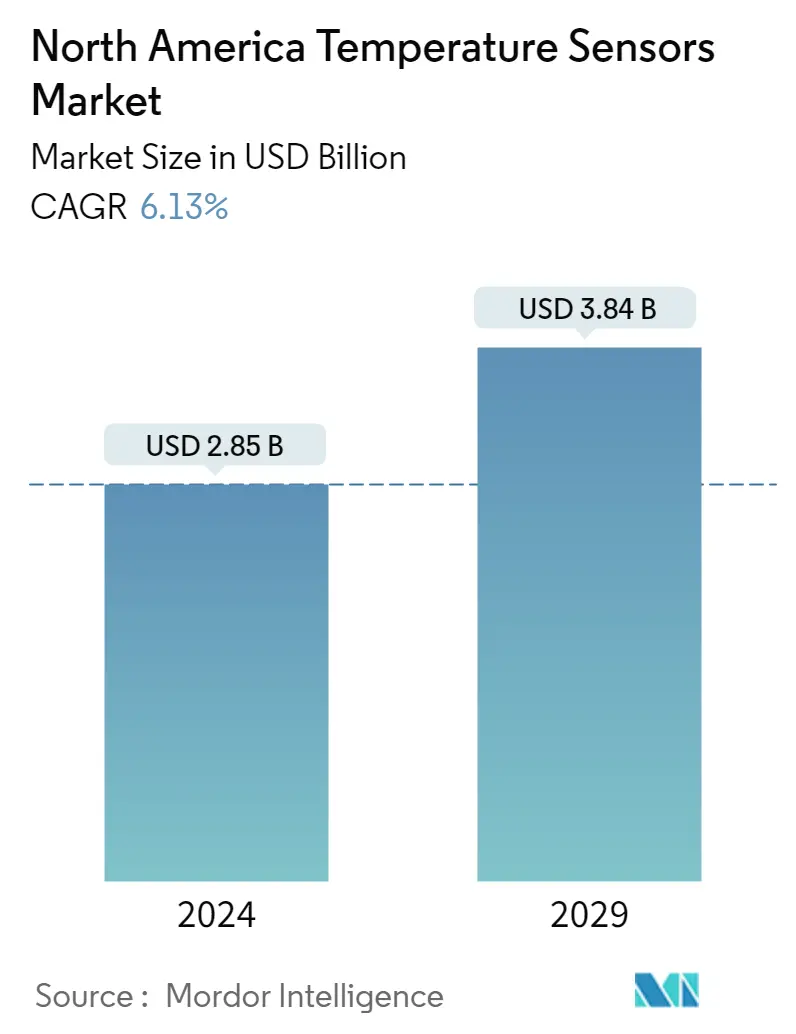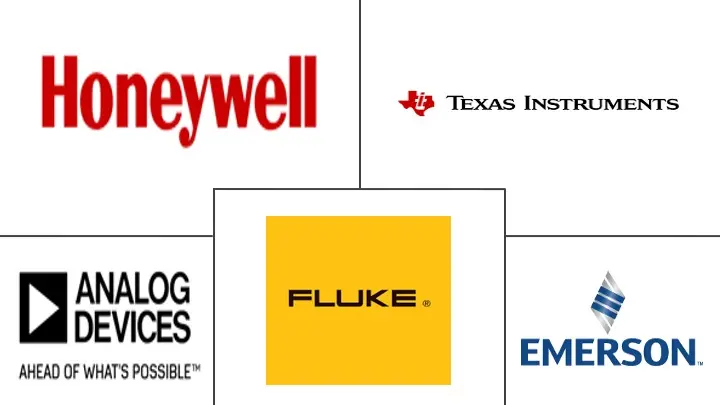Market Size of North America Temperature Sensors Industry

| Study Period | 2019 - 2029 |
| Base Year For Estimation | 2023 |
| Market Size (2024) | USD 2.85 Billion |
| Market Size (2029) | USD 3.84 Billion |
| CAGR (2024 - 2029) | 6.13 % |
| Market Concentration | Medium |
Major Players
*Disclaimer: Major Players sorted in no particular order |
North America Temperature Sensors Market Analysis
The North America Temperature Sensors Market size is estimated at USD 2.85 billion in 2024, and is expected to reach USD 3.84 billion by 2029, growing at a CAGR of 6.13% during the forecast period (2024-2029).
The temperature sensor measures the temperature of its environment and converts the input data into electronic data to record monitor or signal temperature changes. Adopting such process and monitoring automation in industrial and defense operations is the major driver augmenting the demand for wireless sensors in asset monitoring, security, and quality assurance.
- Industries, such as aerospace, oil and gas, and mining, among others, are characterized by the harsh and complex operating environment and the adoption of a suitable sensor to withstand such external environment extremities and performing at the desired accuracy, reliability, precision, and repeatability are of crucial importance for these end-users.
- Rapid technological advancements in temperature monitoring have played a crucial role in the growth of wireless temperature sensors in the past few years. Multiple large-scale manufacturers have been focusing on implementing advanced concepts such as IR sensors and heat sensors. The usage of advanced concepts is further expected to open up significant potential for the market's growth in the coming years.
- With the increase in defense expenditure, wireless type sensors have been an emerging technology area with multiple applications within the defense industry. Applications such as integrated vehicle health monitoring (IVHM) of the defense and aerospace vehicles are primarily needed to ensure the crew's safety and the vehicle.
- At their essence, the sensor networks have been monitoring the physical characteristics of an environment and then translating those physical measurements to electrical impulses. The sensor networks primarily measure characteristics such as temperature, among others. In various cases, the network has been designed to not only sense the environment but also act on the physical environment based on the sensed data.
- Temperature sensors are employing IoT connectivity to speed COVID-19 screening. The market demand for screening process equipment has enabled the demand for temperature sensors where various firms' collaboration to invent new temperature sensor devices has raised significantly. For instance, Polysense Technologies and Semtech have joined forces in developing a series of human body temperature monitoring devices based on Semtech's Long Range (LoRa) Low-Power Wide-Area Network (LPWAN). The sensors offer real-time data to frontline healthcare workers and quickly screen individuals with high temperatures, one of the most common symptoms of COVID-19.
North America Temperature Sensors Industry Segmentation
The temperature sensors are devices to measure temperature readings through electrical signals. The sensor is made of two metals that generate electrical voltage or resistance once it notices a temperature change.
The temperature sensors have various sensor types based on the technology type such as Infrared, Thermocouple, Resistance Temperature Detectors (RTD), Thermistor, and others. The report describes the type of sensors, such as wired and wireless, and also provides the study of output, which are analog and digital. The end-user industry is comprised of temperature sensor applications, and majorly includes Chemical & Petrochemical, Oil & Gas, Metal & Mining, Power Generation, Food & Beverage, Automotive, Medical, Aerospace & Military, and others. The study is also being provided based on the COVID-19 impact.
| By Type | |
| Wired | |
| Wireless |
| By Technology | |
| Infrared | |
| Thermocouple | |
| Resistance Temperature Detector | |
| Thermistor | |
| Temperature Transmitter | |
| Fiber Optic | |
| Others |
| By End-user Industry | |
| Chemical & Petrochemical | |
| Oil and Gas | |
| Metal and Mining | |
| Power Generation | |
| Food and Beverage | |
| Automotive | |
| Medical | |
| Aerospace and Military | |
| Consumer Electronics | |
| Other End-user Industries |
| By Country | |
| United States | |
| Canada |
North America Temperature Sensors Market Size Summary
The North America temperature sensors market is poised for significant growth, driven by the increasing adoption of automation and monitoring technologies across various industries. These sensors play a crucial role in measuring and converting environmental temperatures into electronic data, which is essential for applications in asset monitoring, security, and quality assurance. Industries such as aerospace, oil and gas, and mining require sensors that can withstand harsh conditions while maintaining accuracy and reliability. The market is further bolstered by rapid technological advancements, with manufacturers focusing on integrating advanced concepts like infrared and heat sensors. These innovations are expected to unlock new growth opportunities, particularly in defense applications where wireless sensors are used for vehicle health monitoring and crew safety.
The United States holds a substantial share of the market, supported by advancements in sectors like automotive and oil and gas. The automotive industry, with its significant investment in research and development, is incorporating advanced sensors into vehicles, enhancing their functionality and safety. The oil and gas sector is also expected to create new opportunities with offshore exploratory drilling plans. The COVID-19 pandemic has heightened the demand for temperature sensors for workplace screening, further driving market growth. The market is moderately fragmented, with key players like Honeywell, Analog Devices Inc, and Texas Instruments leading the way through strategic initiatives such as mergers and acquisitions. These developments are contributing to the market's evolution towards highly differentiated offerings.
North America Temperature Sensors Market Size - Table of Contents
-
1. MARKET DYNAMICS
-
1.1 Market Overview
-
1.2 Assessment of Impact of COVID-19 on the Industry
-
1.3 Market Drivers
-
1.3.1 Growth in Industry 4.0 & Rapid Factory Automation
-
1.3.2 Increasing Adoption of Wireless Technologies, especially in Harsh Environments
-
-
1.4 Market Restraints
-
1.4.1 Higher Security Needs and Infrastructure Updating Costs
-
-
1.5 Industry Value Chain Analysis
-
1.6 Industry Attractiveness - Porter's Five Force Analysis
-
1.6.1 Bargaining Power of Suppliers
-
1.6.2 Bargaining Power of Buyers/Consumers
-
1.6.3 Threat of New Entrants
-
1.6.4 Threat of Substitute Products
-
1.6.5 Intensity of Competitive Rivalry
-
-
-
2. MARKET SEGMENTATION
-
2.1 By Type
-
2.1.1 Wired
-
2.1.2 Wireless
-
-
2.2 By Technology
-
2.2.1 Infrared
-
2.2.2 Thermocouple
-
2.2.3 Resistance Temperature Detector
-
2.2.4 Thermistor
-
2.2.5 Temperature Transmitter
-
2.2.6 Fiber Optic
-
2.2.7 Others
-
-
2.3 By End-user Industry
-
2.3.1 Chemical & Petrochemical
-
2.3.2 Oil and Gas
-
2.3.3 Metal and Mining
-
2.3.4 Power Generation
-
2.3.5 Food and Beverage
-
2.3.6 Automotive
-
2.3.7 Medical
-
2.3.8 Aerospace and Military
-
2.3.9 Consumer Electronics
-
2.3.10 Other End-user Industries
-
-
2.4 By Country
-
2.4.1 United States
-
2.4.2 Canada
-
-
North America Temperature Sensors Market Size FAQs
How big is the North America Temperature Sensors Market?
The North America Temperature Sensors Market size is expected to reach USD 2.85 billion in 2024 and grow at a CAGR of 6.13% to reach USD 3.84 billion by 2029.
What is the current North America Temperature Sensors Market size?
In 2024, the North America Temperature Sensors Market size is expected to reach USD 2.85 billion.

